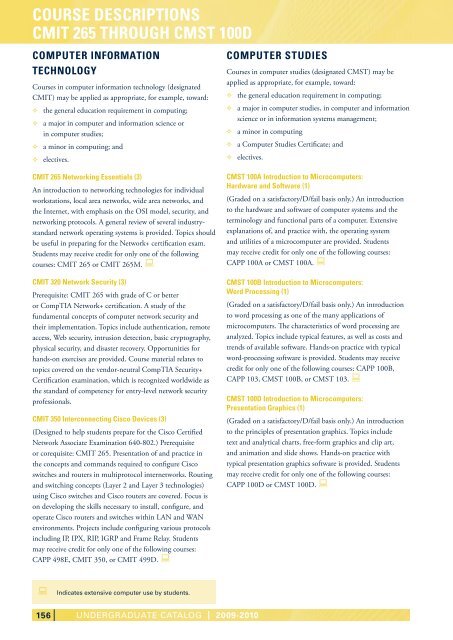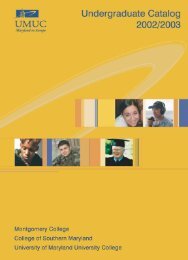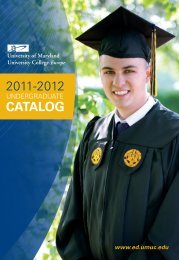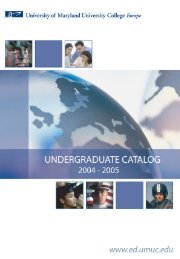UNDERGRADUATE CATALOG - UMUC Europe
UNDERGRADUATE CATALOG - UMUC Europe
UNDERGRADUATE CATALOG - UMUC Europe
Create successful ePaper yourself
Turn your PDF publications into a flip-book with our unique Google optimized e-Paper software.
CouRsE dEsCRiPtions<br />
Cmit 265 tHRougH Cmst 100d<br />
ComPutER inFoRmAtion<br />
tECHnology<br />
Courses in computer information technology (designated<br />
CMIT) may be applied as appropriate, for example, toward:<br />
G the general education requirement in computing;<br />
G a major in computer and information science or<br />
in computer studies;<br />
G a minor in computing; and<br />
G electives.<br />
Cmit 265 networking Essentials (3)<br />
An introduction to networking technologies for individual<br />
workstations, local area networks, wide area networks, and<br />
the Internet, with emphasis on the OSI model, security, and<br />
networking protocols. A general review of several industrystandard<br />
network operating systems is provided. Topics should<br />
be useful in preparing for the Network+ certification exam.<br />
Students may receive credit for only one of the following<br />
courses: CMIT 265 or CMIT 265M. :<br />
Cmit 320 network security (3)<br />
Prerequisite: CMIT 265 with grade of C or better<br />
or CompTIA Network+ certification. A study of the<br />
fundamental concepts of computer network security and<br />
their implementation. Topics include authentication, remote<br />
access, Web security, intrusion detection, basic cryptography,<br />
physical security, and disaster recovery. Opportunities for<br />
hands-on exercises are provided. Course material relates to<br />
topics covered on the vendor-neutral CompTIA Security+<br />
Certification examination, which is recognized worldwide as<br />
the standard of competency for entry-level network security<br />
professionals.<br />
Cmit 350 interconnecting Cisco devices (3)<br />
(Designed to help students prepare for the Cisco Certified<br />
Network Associate Examination 640-802.) Prerequisite<br />
or corequisite: CMIT 265. Presentation of and practice in<br />
the concepts and commands required to configure Cisco<br />
switches and routers in multiprotocol internetworks. Routing<br />
and switching concepts (Layer 2 and Layer 3 technologies)<br />
using Cisco switches and Cisco routers are covered. Focus is<br />
on developing the skills necessary to install, configure, and<br />
operate Cisco routers and switches within LAN and WAN<br />
environments. Projects include configuring various protocols<br />
including IP, IPX, RIP, IGRP and Frame Relay. Students<br />
may receive credit for only one of the following courses:<br />
CAPP 498E, CMIT 350, or CMIT 499D. :<br />
: indicates extensive computer use by students.<br />
156<br />
UndERGRAdUATE CATALoG | 2009-2010<br />
ComPutER studiEs<br />
Courses in computer studies (designated CMST) may be<br />
applied as appropriate, for example, toward:<br />
G the general education requirement in computing;<br />
G a major in computer studies, in computer and information<br />
science or in information systems management;<br />
G a minor in computing<br />
G a Computer Studies Certificate; and<br />
G electives.<br />
Cmst 100A introduction to microcomputers:<br />
Hardware and software (1)<br />
(Graded on a satisfactory/D/fail basis only.) An introduction<br />
to the hardware and software of computer systems and the<br />
terminology and functional parts of a computer. Extensive<br />
explanations of, and practice with, the operating system<br />
and utilities of a microcomputer are provided. Students<br />
may receive credit for only one of the following courses:<br />
CAPP 100A or CMST 100A. :<br />
Cmst 100b introduction to microcomputers:<br />
Word Processing (1)<br />
(Graded on a satisfactory/D/fail basis only.) An introduction<br />
to word processing as one of the many applications of<br />
microcomputers. The characteristics of word processing are<br />
analyzed. Topics include typical features, as well as costs and<br />
trends of available software. Hands-on practice with typical<br />
word-processing software is provided. Students may receive<br />
credit for only one of the following courses: CAPP 100B,<br />
CAPP 103, CMST 100B, or CMST 103. :<br />
Cmst 100d introduction to microcomputers:<br />
Presentation graphics (1)<br />
(Graded on a satisfactory/D/fail basis only.) An introduction<br />
to the principles of presentation graphics. Topics include<br />
text and analytical charts, free-form graphics and clip art,<br />
and animation and slide shows. Hands-on practice with<br />
typical presentation graphics software is provided. Students<br />
may receive credit for only one of the following courses:<br />
CAPP 100D or CMST 100D. :






